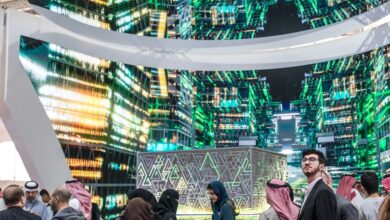Beyond Artificial Intelligence: Take a Look at Arts Integration Too

Antoinette Burton is a professor of History and the director of the Humanities Research Institute at the University of Illinois, Urbana-Champaign. She is a Public Voices Fellow with The OpEd Project.
The scramble in US higher education over how best to capture the runaway train that is artificial intelligence (AI) shows few signs of abating. One thing that is clear, however, is that humanities-based interdisciplinary research is primed to shape conversations in and outside the academy around what counts as intelligence and to investigate “the real-world harms of existing technologies.” In fact, the integration of the arts will be crucial to the responsible incorporation of AI into higher education and society.
AI advances at universities; humanities play a role
A recent report by the Chronicle of Higher Education identified AI as a key threat to academic business as usual for faculty and students – right up there with student debt, demographic changes, and popular skepticism about the value of a college degree.
At the same time, some universities appear to want to make AI central to operations across all sectors of the academy. The University of Michigan has created its own version of ChatGPT, which now has over 16,000 users. The University of Florida is going one step further, proposing to build the first AI University.
The federal government is investing in AI resources at universities. At the University of Illinois, Urbana Champaign, where I teach, The National Center for Supercomputing Applications launched one of the National Science Foundation’s pilot programs, the National Artificial Intelligent Resource (NAIRR). It “aims to connect US researchers and educators to computational, data, and training resources needed to advance AI research and research that employs AI.” Even the National Endowment for the Humanities has issued a call for proposals for the establishment of centers which focus on AI and the Humanities, giving special emphasis to “scholarly activities on exploring the ethical, legal, or societal implications of AI.”
Humanists are well-positioned for this call. Scholars of history and literature have a longstanding interest in the information sciences dating well before AI. And scientists in one 2021 report, alert to the negative societal implications of machine learning, cite research in the humanities and sciences alike which weighs the risks of large-scale language modeling and supports careful curation practices over “ingesting everything on the web.”
Humanists are also actively building in this space. The Critical AI Initiative at Rutgers University hosted a symposium and launched an open-access journal whose first issue leads with the theme “Humanities in the Loop.”
Arts integration has a role to play too
But when it comes to models for how to grapple with institutionalizing innovation so that transformative possibilities are embedded and sustainable, the place to look is not just the humanities.
It’s the other AI we should look to: the Arts Integration movement. Now at least four decades old, it holds annual conferences, offers professional development training for educators, and a has high degree of visibility in colleges and universities, K-12 systems, and arts agencies and platforms.
As the Alliance for the Arts in Research Universities reports, Arts Integration “envisions a world in which universities – students, faculty, and leaders – acknowledge, deeply embed, and seamlessly integrate the arts in the pursuit of basic knowledge and in everyday practice.”
Central to this strategy is a conviction about the indispensability of the arts, whether that’s the performing arts or the visual arts or the spaces in between. But so is the belief that integrating the full range of arts practices goes above and beyond the arts itself because it enhances how leaders can “acknowledge, articulate, and expand the vital role of higher education in our global society.”
In other words, distributing the arts through the entire fabric of the institution advances the university’s mission, exposing a broad range of stakeholders to emerging content and enhancing arts impact along the way.
This is emphatically not the silo model, where AI occupies a central space or produces a spoke-and-wheel effect. As the Kennedy Center in Washington DC describes this approach, it’s neither arts plus curriculum nor arts-enhanced curriculum. In the integration model, the arts are not an add-on. They become “the vehicle for learning.”
Arts Integration is flexible, in part because it works in an interdependent way with multiple subject areas. At Dartmouth University, projects co-led by faculty and students explored arts-based inquiry in subjects as varied as literature, psychology, visual arts, music, biology, artificial intelligence and the environment.
It’s also highly portable to K-12. In the Chicago Public School System, where “quality” AI is a priority in service of fulfilling the state’s expectation of arts participation as a metric in school success, teachers and students are engaged in school-wide projects that center arts knowledge and practice across arts and non-arts classrooms.
AI + AI is the way forward
Advocates for both generative AI and Arts Integration face the same socio-economic conditions of race- and income-based inequity, exclusion, and inaccessibility in education.
Neither tech nor the arts alone are fixes for these underlying structural challenges. And it is not one or the other. Both need to be at the table to shape educational opportunities that are impactful for all.
Given today’s increasingly interconnected algorithmic systems, the siloed approach of the campus artificial intelligence center is very 20th century. Given the combination of start-up costs and the broader economic crisis in higher education, a centralized model of innovation may not be viable in the long term.
The Arts Integration movement offers a reliable example of how to strategize for impact that is as diffuse and multi-sited as the phenomenon of AI itself.
This “other” AI approach is neither cheap nor free. Funders and policy designers seeking high-quality impact approaches for the tech future need to be in conversation with artists and art educators who’ve already blazed the trail. They have successes and invaluable lessons learned to share.
Even better, the federal agencies should collaborate across the arts and tech arenas to fund opportunities to promote collaborative exchange around best practices for access and impact – regardless of which “AI” is at stake.



